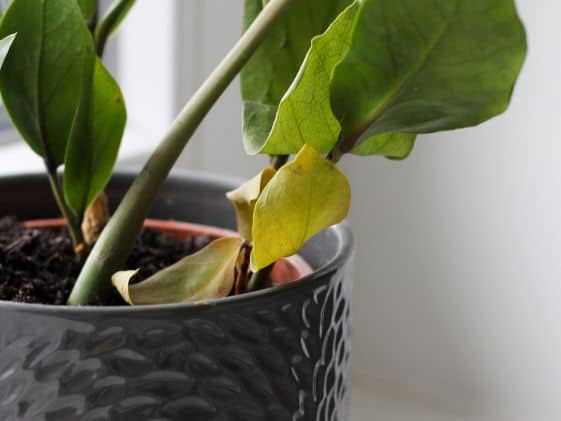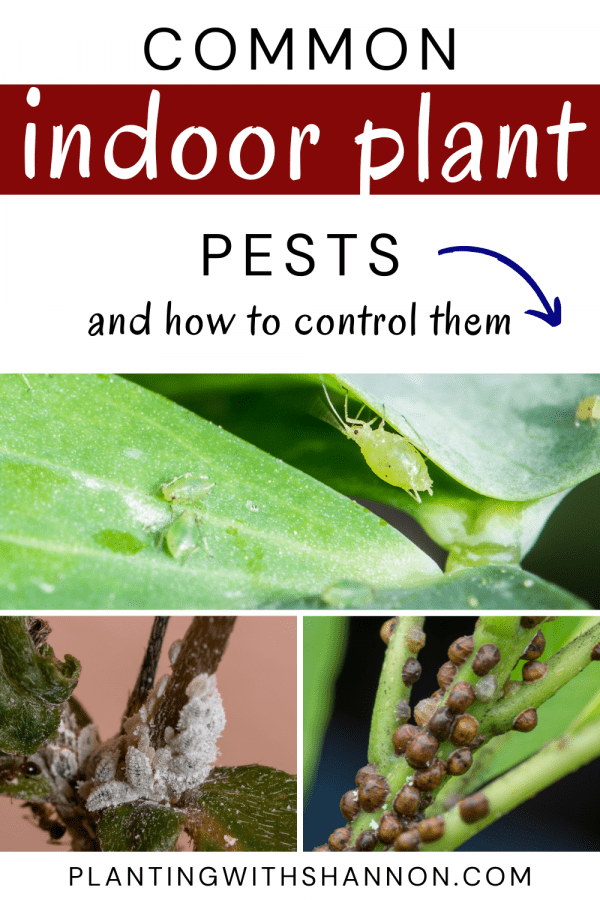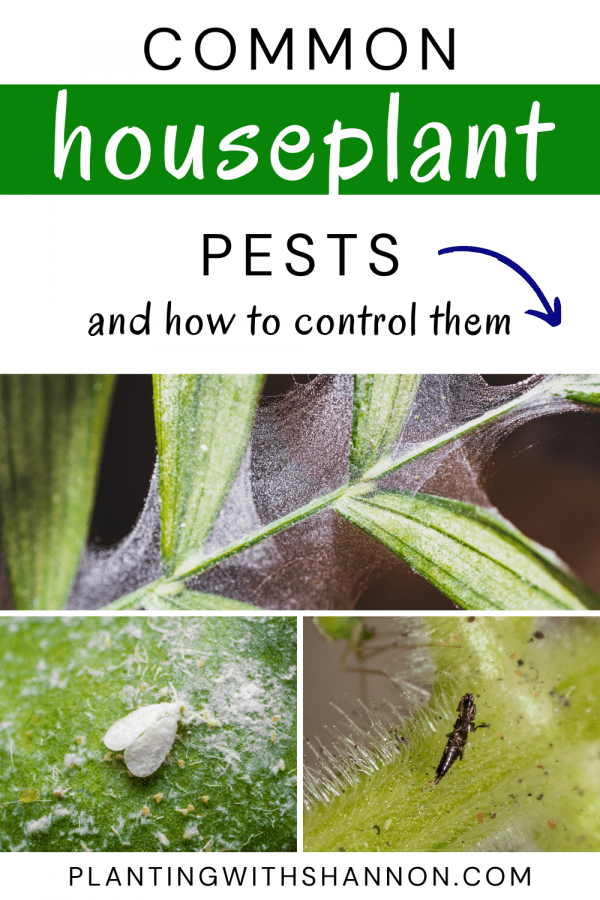If you’re like me, you probably enjoy having plants in your home.
Not only do they add a splash of color and life to a room, but they can also improve your air quality.
However, those plants can also attract pests if you’re not careful.
The good news is, if you have healthy plants, and inspect them regularly, you can save your plants from these pests.
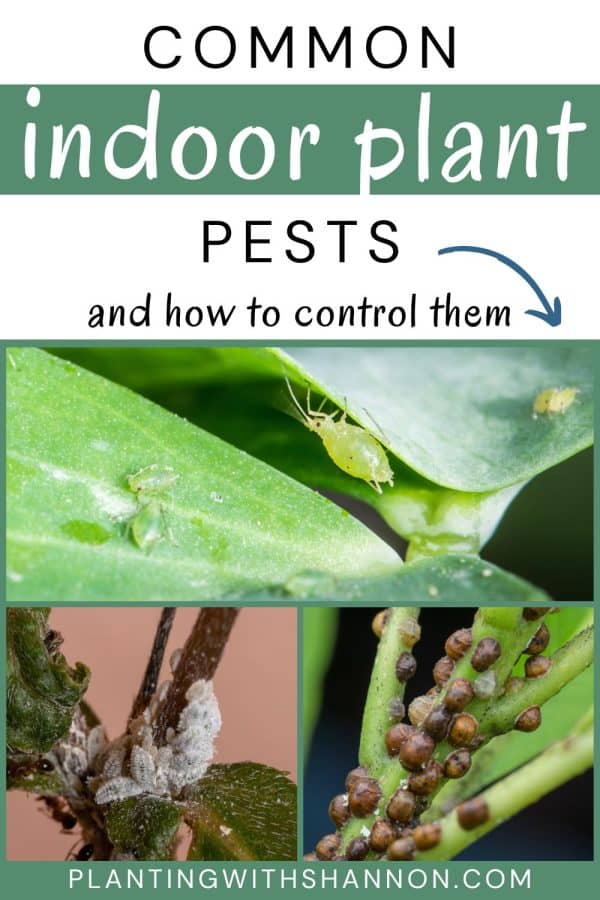
This post may contain affiliate links. That means if you click on them and buy something, I may receive a small commission. Read my Disclaimer Policy to learn more. As an Amazon Associate, I earn from qualifying purchases.
Common Houseplant Pests
Several common pests can infest your houseplants, some causing more issues than others.
Spider Mites
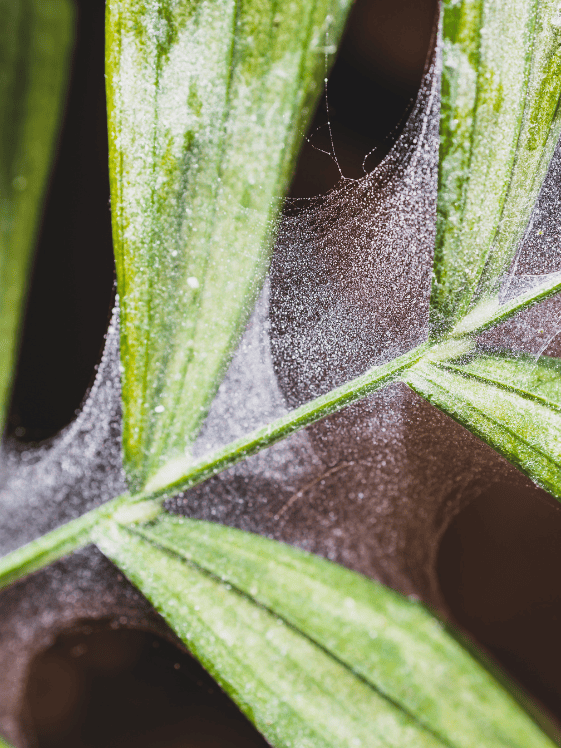
One of the most common pests you’ll find on indoor plants is spider mites.
These tiny creatures are difficult to see with the naked eye, but they can cause a lot of damage to your plants.
They feed by puncturing plant cells and feeding on the sap, causing yellow or brown spots to appear on the leaf.
If left alone this will eventually lead to the plant drooping and eventually kill the plant.
The easiest way to identify spider mites is by the webbing they leave.
This webbing can look like spider webs but is in fact from spider mites.
Heavy spider mite infestations will have small dots moving along the webbing.
How to control spider mites
I like to use a combination of showering the plants and spraying with neem oil.
It can be a labor-intensive process if you have a large number of plants, but it works for me.
It also takes multiple treatments to ensure it gets all of the mites.
I have lost very few plants to spider mites with this process.
Those that I lost were the ones that had the most noticeable infestation, though a few were too stressed by the constantly wet soil from the weekly showers.
To use this method, you spray your plants with water to knock as many spider mites off the leaves as possible.
Make sure to get the undersides of the leaves as well.
You can do this in the shower, with a sink sprayer, or with the hose if it’s nice outside.
I usually just set my plants in the shower and turn it on, using warm, but not too warm, water, and turn the plants and leaves to try to get all surfaces.
This way does soak the dirt, but it’s too hard for me to hold every one of my plants under the water, especially some of the large ones.
Little plants get sprayed in the kitchen sink which is easier to keep the soil dryer.
After spraying the plants, let the leaves dry before applying the neem oil.
Once the leaves are dry, use a spray bottle to spray them with the neem oil mixture.
Make sure to spray both the top and bottom of all the leaves.
Repeat this process every 5 to 7 days for at least 3 or 4 applications.
I usually go 7 days but that is mostly because it’s easier to remember to do it every Saturday than every 5 days.
Check out this post for more information on spider mites and how to get rid of them.
Fungus Gnats
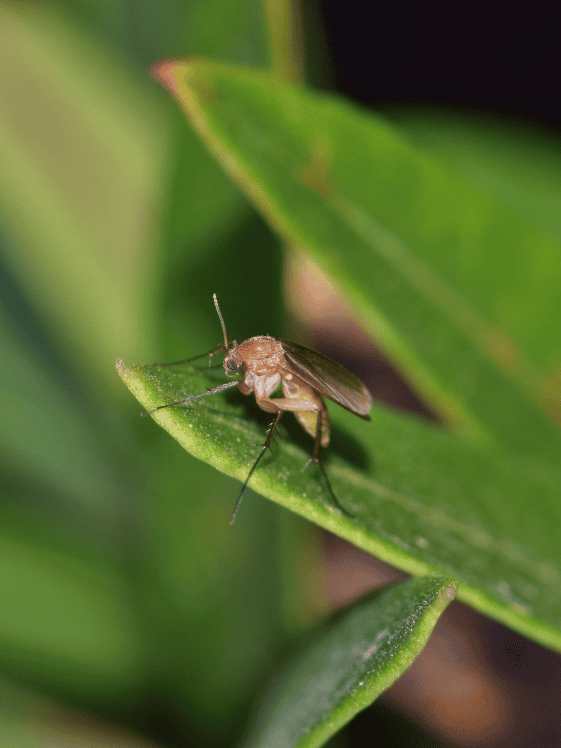
These little black bugs are another common houseplant pest.
You’ll often see them flying around the plant or soil and they’re attracted to damp conditions.
Adult fungus gnats don’t damage plants themselves, but the larvae can.
Fungus gnat larvae can eat the roots of your plants, but they prefer the organic material in the soil that is already breaking down.
They only start eating the roots once this organic matter is gone.
And that takes a very large infestation to get to that point (or your plant has other issues in which case, that issue probably harmed your plant more than the gnats did).
I’ve never had a fungus gnat infestation get bad enough to damage my plants.
Usually, I get too annoyed with the adult gnats long before the population gets large enough to harm my plants.
How to Control Fungus Gnats
Since fungus gnats are not likely to cause much if any damage to my plants, I use the easiest method to get rid of them.
This method is a little slower, but there is little work with it.
I put yellow sticky traps in each pot and wait.
These traps attract the adult fungus gnats and they get stuck to the trap.
Once they are stuck on the trap, they can’t lay any more eggs in the potting soil.
No eggs, no more gnats.
This method takes a while to get rid of all the gnats as it only works on the adults.
You have to wait for all the eggs and larvae that are already in the soil to reach adulthood to get rid of them all.
And, unfortunately, it doesn’t always get all of them, but it usually gets enough to limit the number of gnats flying around.
There is one other downside to this method, one I only discovered after my old cat, Allie, passed away and I got two young cats.
Allie never bothered my plants, but Tsuki and Howl do.
They love walking around my plants, and for some reason, think sticky traps are great to chew on.
They also showed me that sticky traps are great at getting stuck to cat fur.
So, if you have curious cats, sticky traps may not work for you.
If you want faster methods (or have curious cats and want a different method), check out my post on how to get rid of fungus gnats.
Aphids
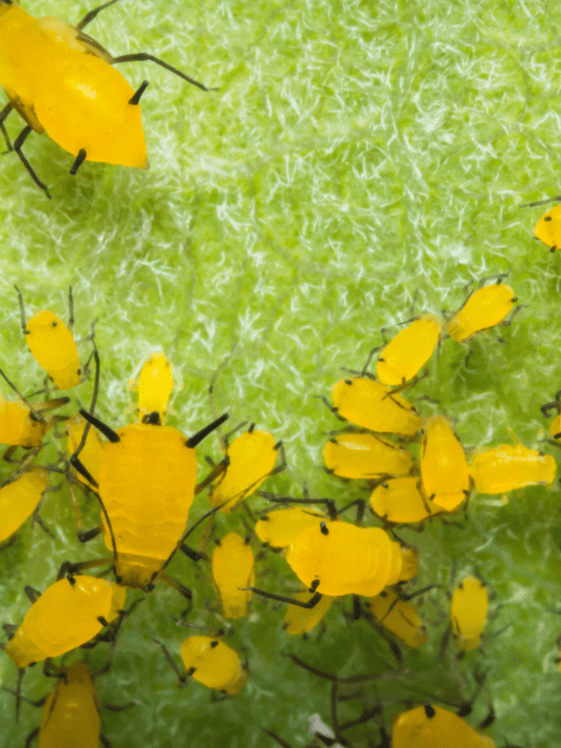
Aphids are small insects that come in a variety of colors, including yellow and green.
You’ll find them on the stems and underside of leaves where they feed on plant sap.
This feeding can cause the plant to deform, stunt its growth, and even kill it if left unchecked.
Aphids also secrete a sticky substance called honeydew.
This can attract other pests and promote the growth of sooty mold.
How to Control Aphids
For small infections, the most effective way to get rid of aphids is to wipe them off with a damp paper towel.
Make sure to squish them as you remove them as this method does not kill them.
If you have more than you want to wipe away by hand, neem oil also works on aphids.
Just spray it on, making sure to get the undersides of the leaves, and repeat weekly for 3 to 4 weeks.
For aphids, I don’t bother spraying them off as it didn’t seem to do anything when I tried.
The aphids stayed put and I was afraid of using more force as I felt it would do more damage to the plants than the aphids were doing.
If you want to combine methods, wipe them off then use the neem oil.
Wiping them off is effective in getting rid of the visible ones and neem oil will help with any that are missed.
For other methods of controlling aphids, check out the post How to Get Rid of Aphids on Houseplants.
Mealybugs
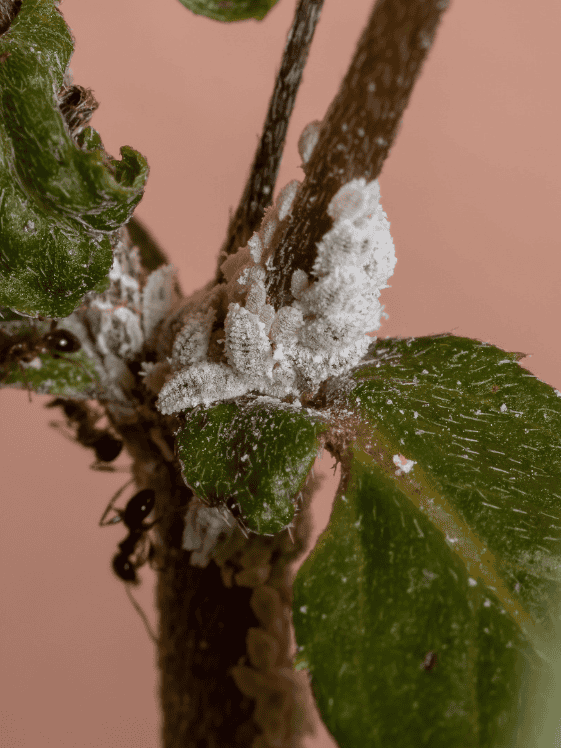
Mealybugs are white, fuzzy-looking bugs that congregate on the stems and undersides of leaves.
Like aphids, they suck the sap out of plants and tend to cause a lot of damage.
They also excrete honeydew which can attract other pests and promote the growth of sooty mold.
Unlike aphids and spider mites, mealybugs can attack the whole plant, including the roots.
This makes them much more difficult to get rid of than either of those.
How to Control Mealybugs
The first step in getting rid of mealybugs is to isolate the infested plant from your other plants.
This will help prevent the spread of mealybugs.
Once you have isolated the plant, you can start working on getting rid of the mealybugs.
The best way to do this is with a cotton swab dipped in rubbing alcohol.
Swipe the cotton swab over the mealybugs and they will die.
You may need to do this a few times to get all of them.
This is a great method for a small mealybug infestation.
For larger infestations check out How to Get Rid of Mealybugs on Houseplants.
Whiteflies
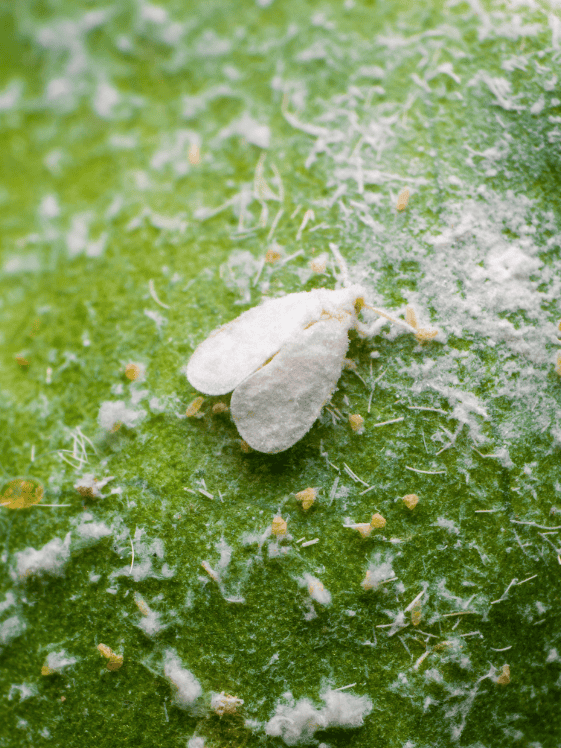
Whiteflies are small, white insects that fly around when disturbed.
These tiny flies tend to congregate on the undersides of leaves where they feed on the plant’s sap.
Whiteflies can cause a lot of damage to plants, especially if there is a large infestation.
The damage includes stunted growth, yellowing leaves, and leaf drop.
Whiteflies also excrete honeydew which can attract other pests and promote the growth of sooty mold.
How to Control Whiteflies
The best way to get rid of whiteflies is with a yellow sticky trap.
These traps are coated with a sticky substance that adult whiteflies are attracted to.
They will fly to the trap and get stuck.
Place the traps near the infested plant and check them regularly.
When they are full, dispose of them and replace them with new ones.
For other methods of getting rid of whiteflies, check out How to Get Rid of Whiteflies on Houseplants.
Brown scale
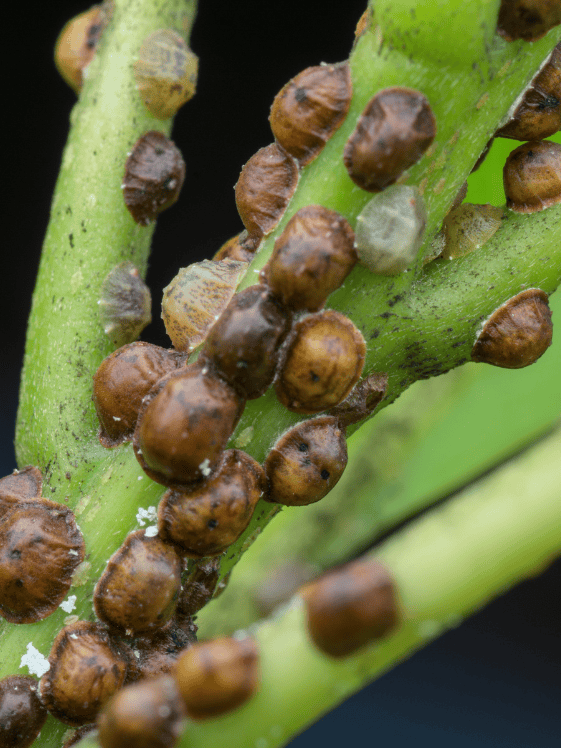
Brown scale is the most common type of soft scale you will find on houseplants.
These pests are small, brown insects that attach themselves to the stems and leaves of plants.
Scale insects excrete sticky honeydew on the leaf surfaces which can attract other pests and promote the growth of sooty mold.
Severe infestations can cause premature leaf drop.
How to Control Brown Scale
The best way to get rid of brown scale is to use a systemic applied to the soil.
This will be taken up by the plant and kill the scale.
Systemics for houseplants can only be used on ornamental plants, not those intended for eating.
If you have brown scales on any food plants, insecticidal soap or horticultural oil are better choices.
How to Get Rid of Brown Scale has more information about brown scale on houseplants.
Thrips
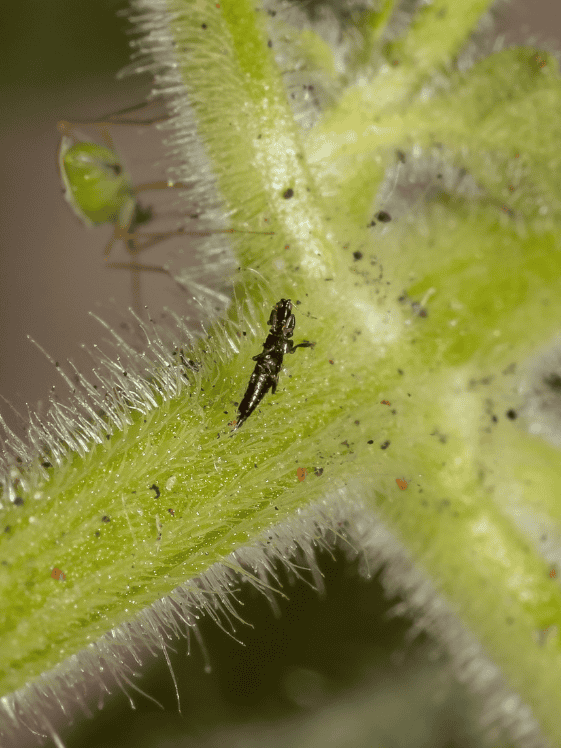
Thrips are small, slender insects that can be black, brown, or yellow.
They feed on the sap of plants and can cause a lot of damage.
Thrips can leave marks on the leaves of your plants as they feed on them.
They can also cause any new growth to be distorted.
How to Control Thrips
The best way to get rid of thrips is with a systemic insecticide.
This will be taken up by the plant and kill all life stages of the thrips.
Yellow sticky traps can be used in addition to systemic insecticide.
This will help reduce the adults while the systemic is working on the rest of the stages of thrips.
Sooty mold
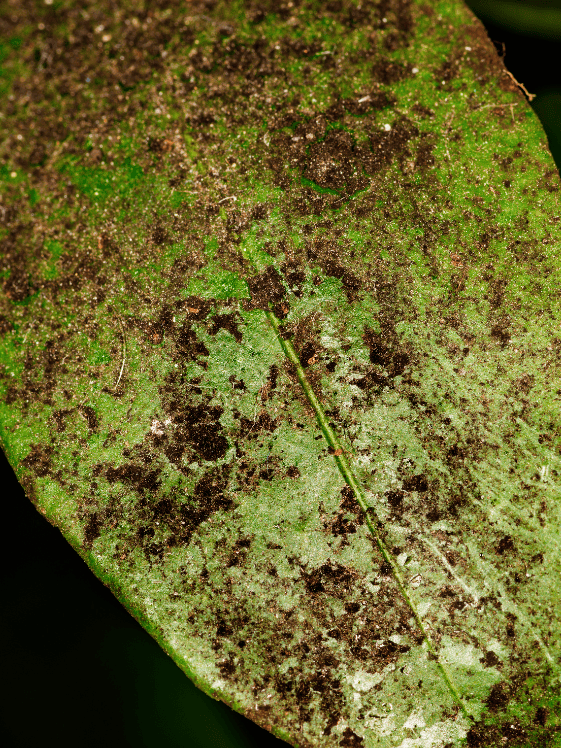
Sooty mold is a black fungus that grows on the honeydew excreted by aphids, whiteflies, and brown scale.
It does not damage the plant directly but can prevent sunlight from reaching the leaves.
This can stunt the growth of the plant by preventing photosynthesis.
How to Control Sooty Mold
The best way to get rid of sooty mold is to control the insects that are excreting the honeydew.
Once the honeydew is gone, the sooty mold can be washed away.
Neem oil is a good option for washing off the sooty mold.
It also does double duty by treating the insects that are producing the honeydew.
For more information on sooty mold, check out How to Get Rid of Sooty Mold.
Best Ways to Prevent a Houseplant Pest Infestation
The best way to prevent houseplant pest infestation is to inspect all new plants before bringing them into the home.
Look for any insects or signs of damage while still at the store.
Don’t buy any plants with visible pest damage.
Even if your new plant has no signs of pests, it’s best to quarantine it from your other plants.
Monitor it for a week or so, checking daily for pests.
This way you catch any pests that weren’t noticeable at the store.
Check all your plants for signs of pests regularly.
The sooner you can catch an infestation, the easier it will be to control.
Another good way to prevent pests is to keep your plants healthy.
Pests are more likely to attack weak or stressed plants.
Give your plants the care they need and they will be less likely to be attacked by pests.
Related Posts
27 Types of Pothos to Grow in Your Home
21 Best Plants To Keep In The Bedroom


